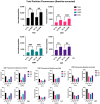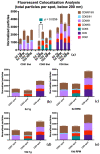Prolonged Exposure to Simulated Microgravity Changes Release of Small Extracellular Vesicle in Breast Cancer Cells
- PMID: 36555738
- PMCID: PMC9781806
- DOI: 10.3390/ijms232416095
Prolonged Exposure to Simulated Microgravity Changes Release of Small Extracellular Vesicle in Breast Cancer Cells
Abstract
Breast cancer is the leading cause of cancer incidence worldwide and among the five leading causes of cancer mortality. Despite major improvements in early detection and new treatment approaches, the need for better outcomes and quality of life for patients is still high. Extracellular vesicles play an important role in tumor biology, as they are able to transfer information between cells of different origins and locations. Their potential value as biomarkers or for targeted tumor therapy is apparent. In this study, we analyzed the supernatants of MCF-7 breast cancer cells, which were harvested following 5 or 10 days of simulated microgravity on a Random Positioning Machine (RPM). The primary results showed a substantial increase in released vesicles following incubation under simulated microgravity at both time points. The distribution of subpopulations regarding their surface protein expression is also altered; the minimal changes between the time points hint at an early adaption. This is the first step in gaining further insight into the mechanisms of tumor progression, metastasis, the education of the tumor microenvironments, and preparation of the metastatic niche. Additionally, this may lighten up the processes of the rapid cellular adaptions in the organisms of space travelers during spaceflights.
Keywords: breast cancer; cell-cell communication; exosomes; extracellular vesicles; microgravity; tetraspanins.
Conflict of interest statement
The authors declare no conflict of interest.
Figures









Similar articles
-
Changes in Exosome Release in Thyroid Cancer Cells after Prolonged Exposure to Real Microgravity in Space.Int J Mol Sci. 2021 Feb 21;22(4):2132. doi: 10.3390/ijms22042132. Int J Mol Sci. 2021. PMID: 33669943 Free PMC article.
-
Long-Term Simulation of Microgravity Induces Changes in Gene Expression in Breast Cancer Cells.Int J Mol Sci. 2023 Jan 7;24(2):1181. doi: 10.3390/ijms24021181. Int J Mol Sci. 2023. PMID: 36674696 Free PMC article.
-
Investigating alterations in the cellular envelope of Staphylococcus aureus in simulated microgravity using a random positioning machine.Life Sci Space Res (Amst). 2021 Aug;30:1-8. doi: 10.1016/j.lssr.2021.04.001. Epub 2021 Apr 6. Life Sci Space Res (Amst). 2021. PMID: 34281660
-
Omics Studies of Specialized Cells and Stem Cells under Microgravity Conditions.Int J Mol Sci. 2024 Sep 17;25(18):10014. doi: 10.3390/ijms251810014. Int J Mol Sci. 2024. PMID: 39337501 Free PMC article. Review.
-
Tissue Engineering Under Microgravity Conditions-Use of Stem Cells and Specialized Cells.Stem Cells Dev. 2018 Jun 15;27(12):787-804. doi: 10.1089/scd.2017.0242. Epub 2018 Mar 29. Stem Cells Dev. 2018. PMID: 29596037 Review.
Cited by
-
Physical modulation of mesenchymal stem cell exosomes: A new perspective for regenerative medicine.Cell Prolif. 2024 Aug;57(8):e13630. doi: 10.1111/cpr.13630. Epub 2024 Mar 10. Cell Prolif. 2024. PMID: 38462759 Free PMC article. Review.
-
Current Knowledge about the Impact of Microgravity on Gene Regulation.Cells. 2023 Mar 29;12(7):1043. doi: 10.3390/cells12071043. Cells. 2023. PMID: 37048115 Free PMC article. Review.
-
Omics Studies of Tumor Cells under Microgravity Conditions.Int J Mol Sci. 2024 Jan 11;25(2):926. doi: 10.3390/ijms25020926. Int J Mol Sci. 2024. PMID: 38255998 Free PMC article. Review.
-
Recent studies of the effects of microgravity on cancer cells and the development of 3D multicellular cancer spheroids.Stem Cells Transl Med. 2025 Mar 18;14(3):szaf008. doi: 10.1093/stcltm/szaf008. Stem Cells Transl Med. 2025. PMID: 40099549 Free PMC article. Review.
-
Recent Advances in Breast Cancer Research.Int J Mol Sci. 2023 Jul 26;24(15):11990. doi: 10.3390/ijms241511990. Int J Mol Sci. 2023. PMID: 37569366 Free PMC article.
References
-
- Wild C., Weiderpass E., Stewart B. World Cancer Report: Cancer Research for Cancer Prevention. International Agency for Research on Cancer; Lyon, France: 2020.
-
- Brinton L.A., Gierach G.L. Breast Cancer. In: Thun M.J., Linet M.S., Cerhan J.R., Haiman C.A., Schottenfeld D., editors. Cancer Epidemiology and Prevention. 4th ed. Oxford University Press; Oxford, UK: 2018. pp. 861–888.
MeSH terms
Grants and funding
LinkOut - more resources
Full Text Sources
Medical

